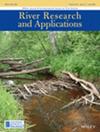An enhanced and expanded Toolbox for River Velocimetry using Images from Aircraft (TRiVIA)
IF 1.9
4区 环境科学与生态学
Q4 ENVIRONMENTAL SCIENCES
引用次数: 0
Abstract
Detailed, accurate information on flow patterns in river channels can improve understanding of habitat conditions, geomorphic processes, and potential hazards to help inform water management. Data describing flow patterns in river channels can be obtained efficiently via image‐based techniques that have become more widely used in recent years as the number of platforms for acquiring images has expanded and the number of algorithms for inferring velocities has grown. Image‐based techniques have been incorporated into various software packages, including the Toolbox for River Velocimetry using Images from Aircraft (TRiVIA). TRiVIA is a freely available, standalone computer program that provides a comprehensive workflow for performing particle image velocimetry (PIV)‐based analyses within a graphical interface. This paper summarizes major enhancements incorporated into the latest release of TRiVIA, version 2.1. For example, a new Tool for Input Parameter Selection (TIPS) provides guidance for specifying key inputs to the PIV algorithm by allowing users to explore relationships between flow velocity, pixel size, output vector spacing, and frame interval. Improved visualization capabilities include the ability to create streamlines and display PIV output on an interactive web map. The program now provides greater flexibility for importing field data in various formats and selecting which observations to use for accuracy assessment. The most substantial additions to TRiVIA 2.1 are the ability to integrate bathymetric information with image‐derived velocity estimates to calculate river discharge and to use images acquired from moving aircraft to efficiently map long segments of large rivers to support habitat assessment, contaminant transport studies, and a range of other applications.利用飞机图像进行河流流速测量的增强型扩展工具箱(TRiVIA)
有关河道水流模式的详细而准确的信息可以提高人们对栖息地条件、地貌过程和潜在危害的认识,从而为水资源管理提供依据。描述河道水流模式的数据可以通过基于图像的技术高效获取,近年来,随着获取图像的平台数量不断增加,推断流速的算法也越来越多,这种技术得到了更广泛的应用。基于图像的技术已被纳入各种软件包,包括利用飞机图像进行河流流速测量的工具箱(TRiVIA)。TRiVIA 是一款免费提供的独立计算机程序,它提供了一个全面的工作流程,可在图形界面上执行基于粒子图像测速(PIV)的分析。本文总结了 TRiVIA 最新发布的 2.1 版的主要增强功能。例如,新的输入参数选择工具(TIPS)通过允许用户探索流速、像素尺寸、输出矢量间距和帧间隔之间的关系,为指定 PIV 算法的关键输入提供了指导。改进后的可视化功能包括创建流线和在交互式网络地图上显示 PIV 输出。现在,该程序在导入各种格式的现场数据和选择用于精度评估的观测数据方面提供了更大的灵活性。TRiVIA 2.1 最重要的新增功能包括:将测深信息与源自图像的速度估计值进行整合,以计算河流排水量;利用从移动飞机上获取的图像,高效绘制大河的长河段地图,以支持栖息地评估、污染物迁移研究以及一系列其他应用。
本文章由计算机程序翻译,如有差异,请以英文原文为准。
求助全文
约1分钟内获得全文
求助全文
来源期刊

River Research and Applications
环境科学-环境科学
CiteScore
4.60
自引率
9.10%
发文量
158
审稿时长
6 months
期刊介绍:
River Research and Applications , previously published as Regulated Rivers: Research and Management (1987-2001), is an international journal dedicated to the promotion of basic and applied scientific research on rivers. The journal publishes original scientific and technical papers on biological, ecological, geomorphological, hydrological, engineering and geographical aspects related to rivers in both the developed and developing world. Papers showing how basic studies and new science can be of use in applied problems associated with river management, regulation and restoration are encouraged as is interdisciplinary research concerned directly or indirectly with river management problems.
 求助内容:
求助内容: 应助结果提醒方式:
应助结果提醒方式:


